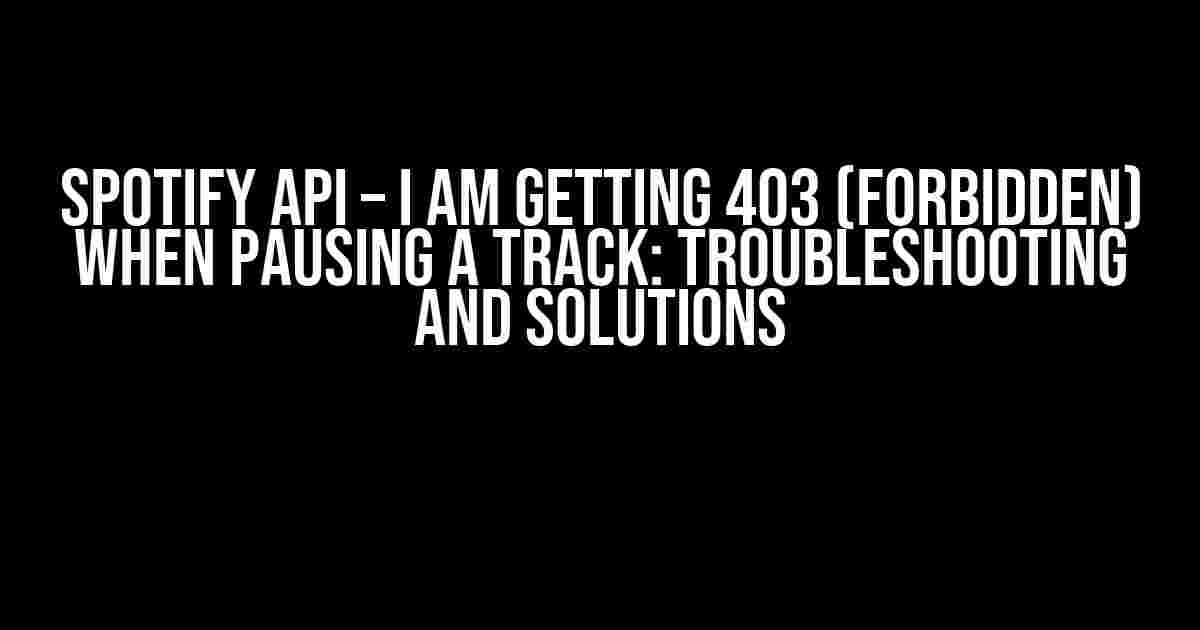Ah, the frustration of encountering a 403 (Forbidden) error when trying to pause a track using the Spotify API! Don’t worry, you’re not alone. In this article, we’ll delve into the possible causes of this issue and provide step-by-step solutions to get you back to smoothly controlling your users’ music experiences.
What’s a 403 (Forbidden) Error?
A 403 error is an HTTP status code that indicates the server understood the request but refuses to authorize it. In the context of the Spotify API, this means the API is refusing to pause the track due to insufficient privileges or incorrect authentication.
Possible Causes of 403 Errors
Before we dive into fixes, let’s explore some common reasons behind the 403 error when pausing a track using the Spotify API:
- Invalid or Missing Authentication Tokens: Make sure you’re providing a valid access token with the necessary permissions.
- Insufficient Permissions: Verify that your application has the required permissions to control playback.
- Rate Limiting Issues: Check if you’re exceeding the API’s rate limits, which can lead to temporary or permanent bans.
- Incorrect Request Headers or Payload: Double-check your request headers and payload for any errors or inconsistencies.
- Server-Side Issues: Although rare, it’s possible that Spotify’s servers are experiencing issues or maintenance, causing the error.
Troubleshooting Steps
Follow these steps to identify and resolve the 403 error:
- Verify Your Authentication Tokens:
// Check your access token's expiration and scope curl -X GET \ https://api.spotify.com/v1/me/player/currently-playing \ -H 'Authorization: Bearer YOUR_ACCESS_TOKEN'Ensure the token is valid and includes the necessary permissions (e.g., `user-modify-playback-state`).
- Check Your Permissions:
Permission Description user-modify-playback-staterequired for controlling playback, including pausing tracks Make sure your application has the required permissions. You can check your app’s permissions in the Spotify Developer Dashboard.
- Review Your Request Headers and Payload:
// Ensure your request header includes the necessary authorization and content type curl -X PATCH \ https://api.spotify.com/v1/me/player/pause \ -H 'Authorization: Bearer YOUR_ACCESS_TOKEN' \ -H 'Content-Type: application/json'Verify that your request headers and payload conform to the API’s expectations.
- Monitor API Rate Limits:
- Check the API rate limits and ensure you’re not exceeding them.
- Implement rate limiting and retry mechanisms to avoid temporary or permanent bans.
- Server-Side Issues:
- Check the Spotify API Status Page for any reported issues or maintenance.
- Try pausing the track again after a short delay to see if the issue resolves itself.
Solutions and Workarounds
Based on the troubleshooting steps above, here are some solutions and workarounds to help you resolve the 403 error:
Invalid or Missing Authentication Tokens
If you’re using an invalid or missing access token:
- Refresh Your Access Token: Use the `refresh_token` grant type to obtain a new access token.
- Re-authorize Your Application: Guide the user through the authorization flow again to obtain a new access token.
Insufficient Permissions
If your application lacks the necessary permissions:
- Update Your Permissions: Add the required permissions to your application in the Spotify Developer Dashboard.
- Re-authorize Your Application: Guide the user through the authorization flow again to obtain a new access token with the updated permissions.
Rate Limiting Issues
To avoid rate limiting issues:
- Implement Rate Limiting Mechanisms: Use exponential backoff, retries, and caching to handle rate limiting.
- Use Bulk Operations: Batch requests to reduce the number of API calls and minimize the risk of rate limiting.
Incorrect Request Headers or Payload
To fix request header or payload issues:
- Verify Your Request Headers: Double-check that your request headers conform to the API’s expectations.
- Validate Your Request Payload: Ensure your request payload is correctly formatted and includes all required parameters.
Conclusion
By following these troubleshooting steps and solutions, you should be able to identify and resolve the 403 error when pausing a track using the Spotify API. Remember to:
- Verify your authentication tokens and permissions.
- Review your request headers and payload.
- Monitor API rate limits and implement rate limiting mechanisms.
- Check for server-side issues and consider using workarounds.
With patience and persistence, you’ll be able to provide a seamless music experience for your users. Happy coding!
Frequently Asked Question
Get the scoop on Spotify API errors and how to troubleshoot them!
What could be causing the 403 Forbidden error when pausing a track using Spotify API?
A 403 Forbidden error usually indicates that the API request is valid, but the server is refusing to authorize it. This might be due to an issue with your app’s permissions, token scope, or the user’s account settings. Check that your app has the necessary permissions to control playback (e.g., `user-modify-playback-state` scope) and that the user has granted the required permissions.
Is the 403 error related to the OAuth token or the API endpoint I’m using?
It’s likely related to the OAuth token. Make sure you’re using a valid, non-expired token with the correct scope (e.g., `user-modify-playback-state`) and that it’s properly authorized for the user. If you’re unsure, try re-authorizing the user or checking the token’s expiration time.
Can I troubleshoot the issue by checking the API request and response?
Absolutely! Check the API request and response to identify any issues. You can use tools like Postman or cURL to send the request and inspect the response. Look for any errors, warnings, or messages that might indicate the cause of the 403 error. You can also check the Spotify API documentation to ensure you’re using the correct endpoint and parameters.
What if I’m still stuck and can’t resolve the issue?
Don’t worry! If you’ve tried the above steps and still can’t resolve the issue, you can reach out to the Spotify API community or create a new topic on the Spotify API forum. Provide as much detail as possible about your issue, including the API request, response, and any error messages you’ve received. The community or Spotify API team can help you troubleshoot the issue further.
Are there any additional resources available to help me troubleshoot Spotify API issues?
Yes! Spotify provides extensive documentation and resources to help you troubleshoot API issues. Check out the Spotify API documentation, the Spotify API forum, and the Spotify Developer Community on GitHub. You can also search for similar issues on Stack Overflow or other developer forums.


